MARIANI’S
Virtual
Gourmet
September
12, 2021
NEWSLETTER
IN THIS ISSUE
VILLERS-SUR-MER
By John Mariani
NEW YORK CORNER
CHAZZ PALMINTERI WHITE PLAINS
By John Mariani
CAPONE'S GOLD
CHAPTER TWENTY-FOUR
By John Mariani
NOTES FROM THE WINE CELLAR
WHY ARE BORDEAUX AND BURGUNDY
SLIPPING AMONG THE WORLD'S TOP WINES?
By John Mariani
❖❖❖
 great Civil Rights
Movement songs of the 1950s-60s,
including Nine Simone (right), Mahalia
Jackson, Billie Holiday, and others. at
11AM EDT. Go to: WVOX.com.
The episode will also be archived at: almostgolden.
great Civil Rights
Movement songs of the 1950s-60s,
including Nine Simone (right), Mahalia
Jackson, Billie Holiday, and others. at
11AM EDT. Go to: WVOX.com.
The episode will also be archived at: almostgolden.❖❖❖
VILLERS-SUR-MER
By John Mariani
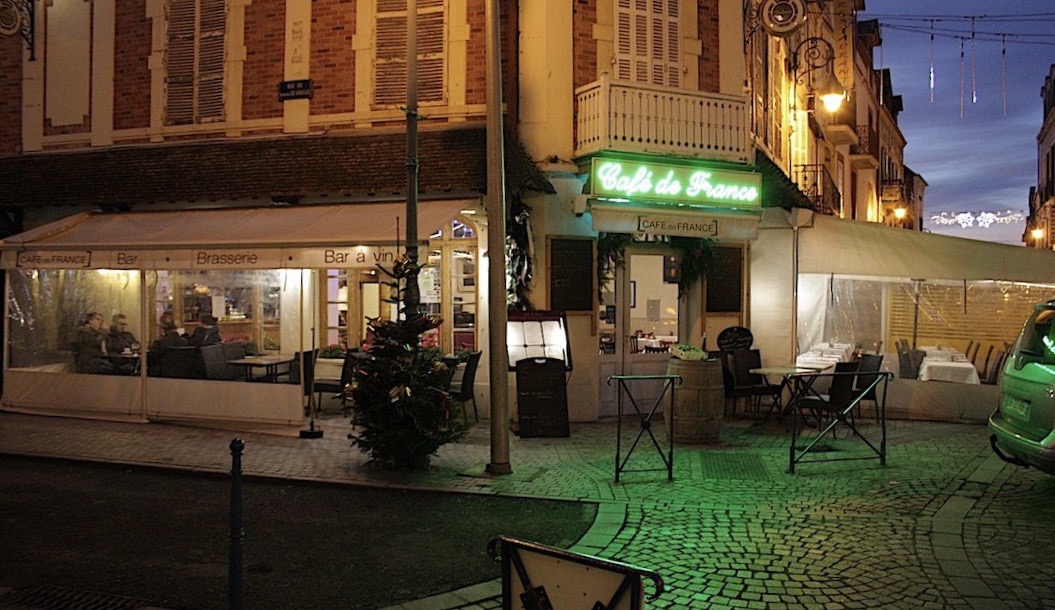
It is hardly worth repeating that Paris
is not France, just as New York
is not America and London not England. And it is
not really true that the soul
of those countries is to be found in any random
small town. But if you wish to
experience something of the spirit of a
particular region in France, like
Normandy, a village like Villers-sur-Mer on the
English Channel can be
rewarding, because very little changes in such a
place. It looks very much the
way Impressionist Gustave Caillebotte painted
the village in 1880, with two
seaside buildings 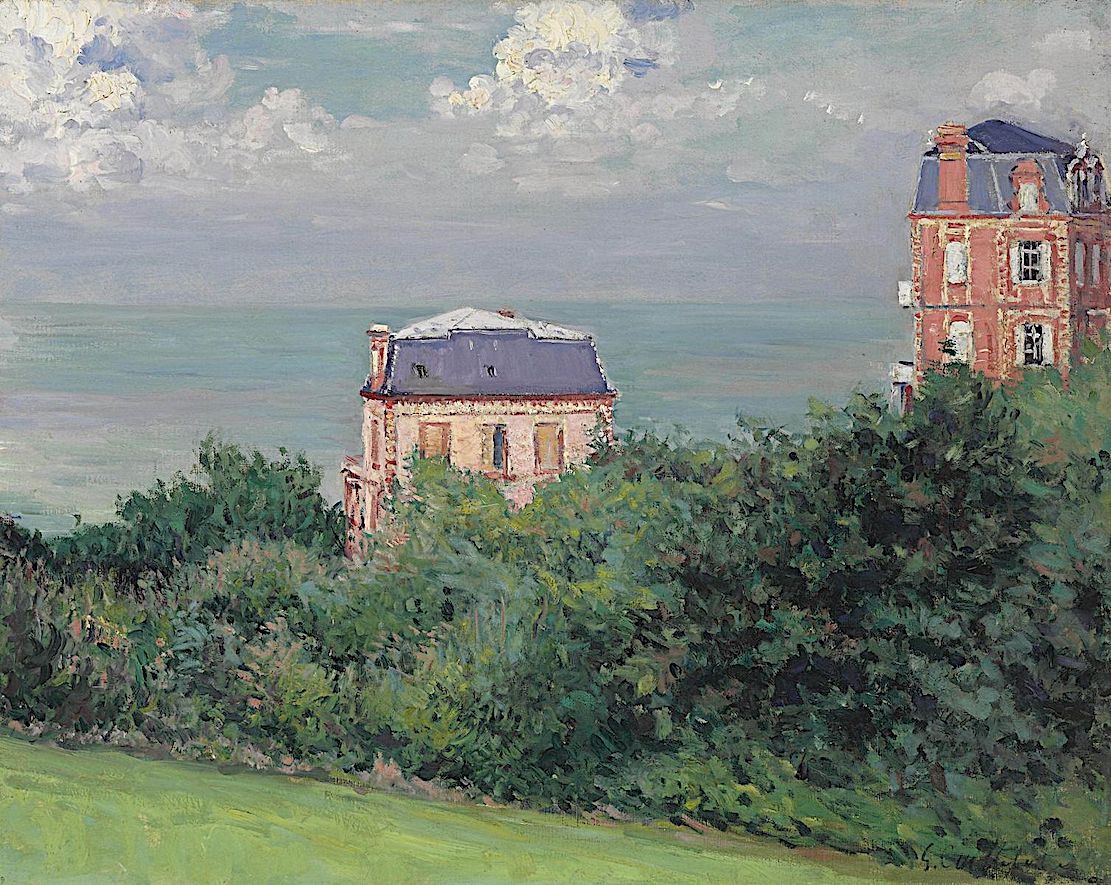 (left)
that are still standing.
(left)
that are still standing.
With only 2,600 residents, Villers-sur-Mer
is not in danger of a
population explosion, and it was with good reason
that François Truffaut, in
his 1989 film The 400 Blows,
shot the
famous final scene here of his young hero’s escape
from the stifling atmosphere of
Paris in order to walk beside a sea he had never
seen (below). 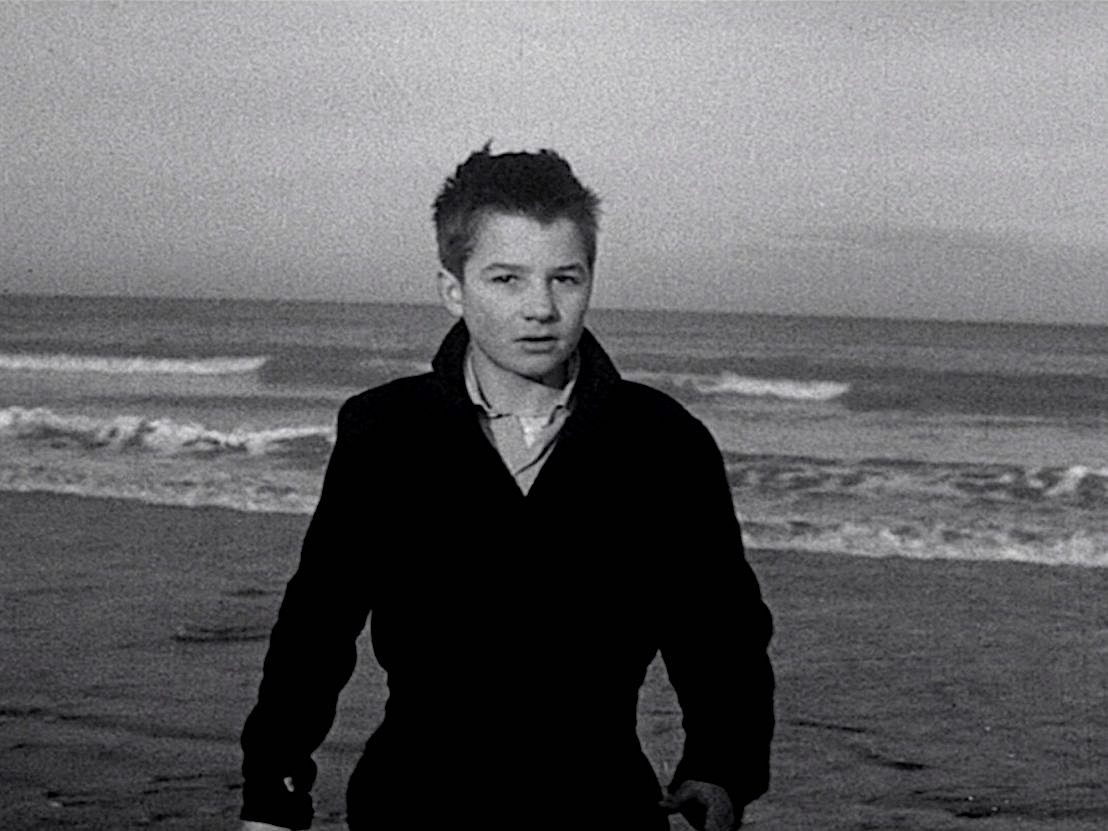
The sea still looks and smells the same to
everyone, lapping the shore
most days, whipped to a foaming tempest on others.
You can still see the
well-kempt topiary dinosaurs that reference the
town’s extensive fossil
deposits. In fact, there is a Paléospace l’Odyssée
museum and planetarium
exhibiting the reconstructed creatures.
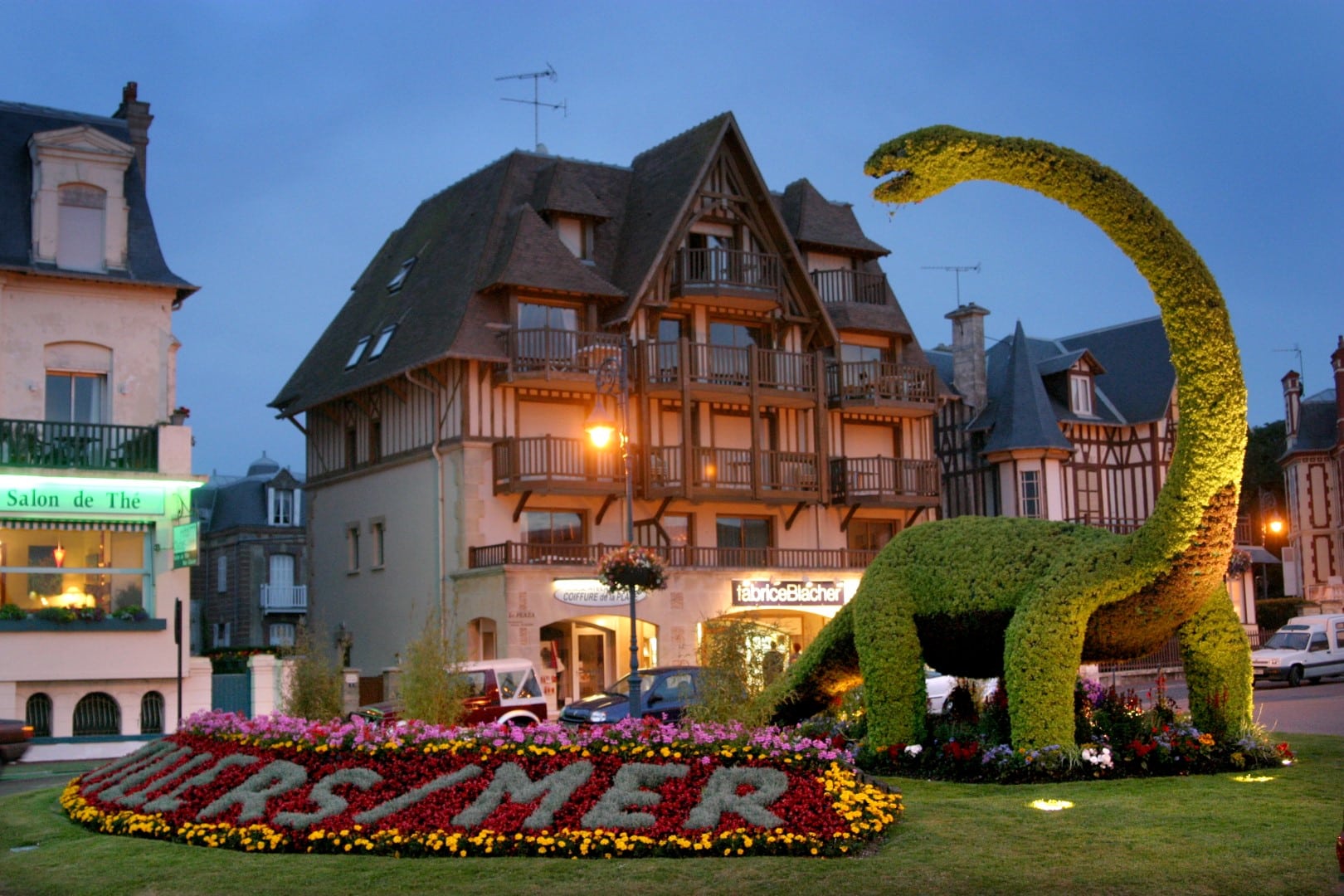 Villers spreads over 700 acres of the
countryside and its curving
crescent beach has a quiet, comforting appeal for
the French on holiday who are
tired of the hard, stony strands of the Riviera.
The cliffs of Vaches Noires
are a backdrop, and there is a sanctuary on an
islet, so the skies fill with
birds, each with their own songs. St. Martin’s
church is an impressive 19th
century neo-Gothic structure for such a
Villers spreads over 700 acres of the
countryside and its curving
crescent beach has a quiet, comforting appeal for
the French on holiday who are
tired of the hard, stony strands of the Riviera.
The cliffs of Vaches Noires
are a backdrop, and there is a sanctuary on an
islet, so the skies fill with
birds, each with their own songs. St. Martin’s
church is an impressive 19th
century neo-Gothic structure for such a  small
town.
small
town.
Villers is in the northern commune of
Calvados, so sampling the local
ciders and powerful spirit are requisite, as well
as Normandy’s marvelous cow’s
milk Camembert cheese, developed by a local farm
woman back in 1791. The
region’s Red Label scallops are widely regarded as
among the best in Europe,
and fishing them is a leading industry, with the
painted boats bobbing in the
harbor. For good reason, then, Villers holds an
October scallop festival. The
outdoor market (left, below) is a
repository of Normandy foods with all the region’s
seasonal
provender, right now teeming with wild mushrooms.
It would not take long on foot to tour the
village and its surrounding
sights, and the streets are rimmed with quaint old
half-timbered and brick
houses, shops, cafés and restaurants.
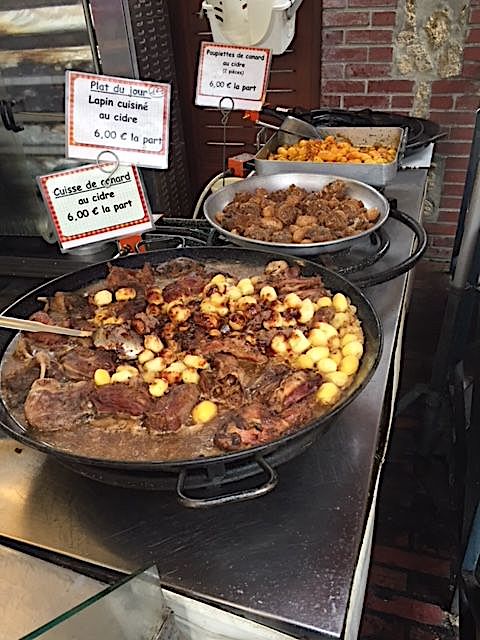 Where
to stay in Villers depends on your budget, but the
town is not
rich in first-class hotels, though the
well-appointed Domaine de Villers &
Spa outside of town, with its indoor
swimming pool and nearness to the beach,
certainly is, with room rates currently under 250€
per night. We stayed
downtown at a comfortable, if not elegant,
boutique Hôtel des Falaises, on the
Rue du Maréchal Foch, within steps of just about
everything you’ll want to see
in town. Breakfast
is included in room
rates under 100€ per night. Bathrooms, however,
are cramped.
Where
to stay in Villers depends on your budget, but the
town is not
rich in first-class hotels, though the
well-appointed Domaine de Villers &
Spa outside of town, with its indoor
swimming pool and nearness to the beach,
certainly is, with room rates currently under 250€
per night. We stayed
downtown at a comfortable, if not elegant,
boutique Hôtel des Falaises, on the
Rue du Maréchal Foch, within steps of just about
everything you’ll want to see
in town. Breakfast
is included in room
rates under 100€ per night. Bathrooms, however,
are cramped. 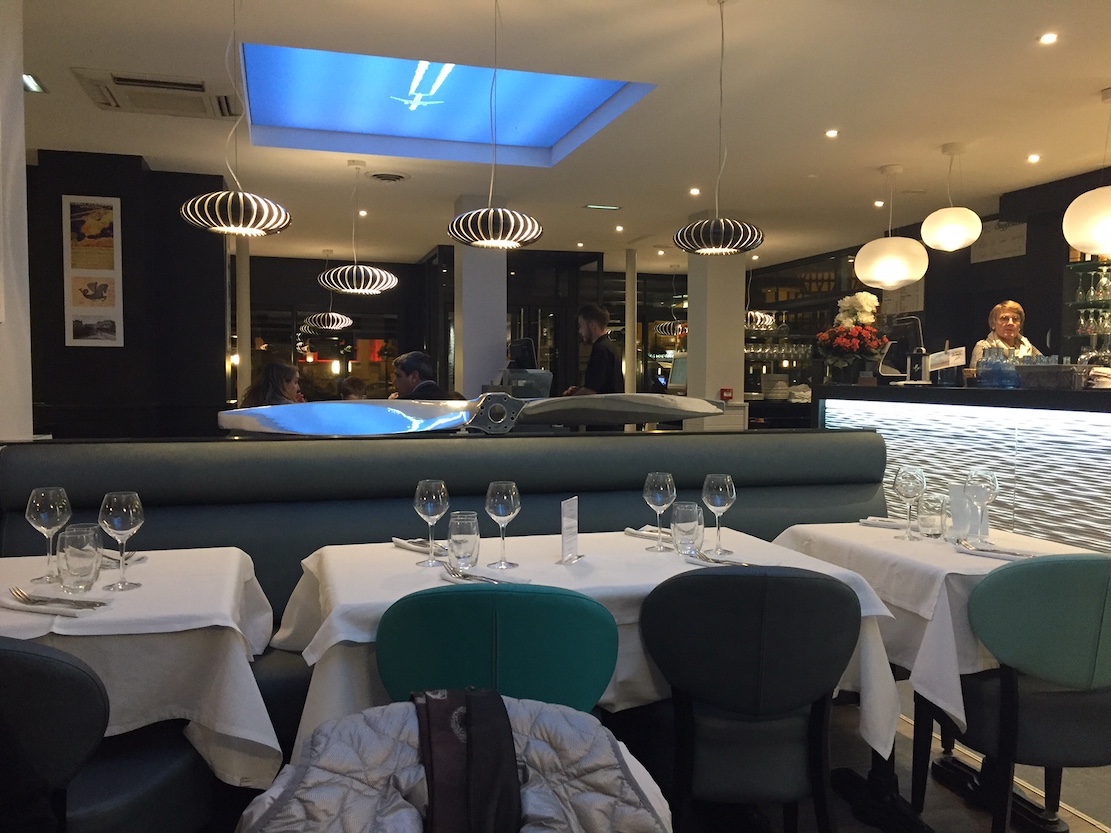
The restaurants of Villers, as you’d
expect, feature the bounty of the
sea on every menu, and they are generally full of
locals. La Mermoz, on the Place Mermoz (right),
has a modern cast to the décor with
glass walls overlooking the beach. It has large,
luxurious banquettes, globe
lighting, sea foam colors and an oddly swanky bar,
as well as outdoor tables.
Portions are very generous, with fixed price menus
at 31€, 27€ and 24€, as well
as à la carte.
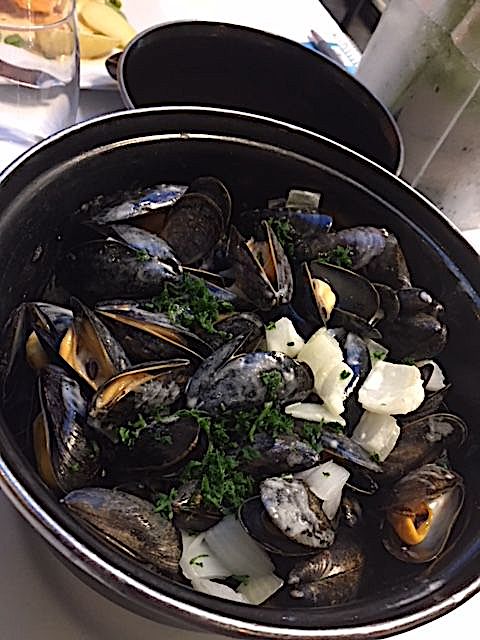 All French seaside restaurants are proud of
and judged by their soupe des
poissons with the requisite
garlicky rouille
mayonnaise, Gruyère
and croutons, and Le Mermoz’s is remarkably light
while deeply flavorful. Fat
pink boiled crevettes
were tender and
sweet, and a terrine of wild boar was a
particularly welcome choice in autumn.
The chef presented us with a huge sole à
la meunière in a pool of golden Normandy
butter, while a rouget
(red mullet) had a far more
subtle taste than the species in cream) are a
specialty of Normandy made with
tiny, tender bivalves scented with herbs and
curry. Smoked haddock was rather dull.
The best of the desserts we tried was the
chocolate
All French seaside restaurants are proud of
and judged by their soupe des
poissons with the requisite
garlicky rouille
mayonnaise, Gruyère
and croutons, and Le Mermoz’s is remarkably light
while deeply flavorful. Fat
pink boiled crevettes
were tender and
sweet, and a terrine of wild boar was a
particularly welcome choice in autumn.
The chef presented us with a huge sole à
la meunière in a pool of golden Normandy
butter, while a rouget
(red mullet) had a far more
subtle taste than the species in cream) are a
specialty of Normandy made with
tiny, tender bivalves scented with herbs and
curry. Smoked haddock was rather dull.
The best of the desserts we tried was the
chocolate 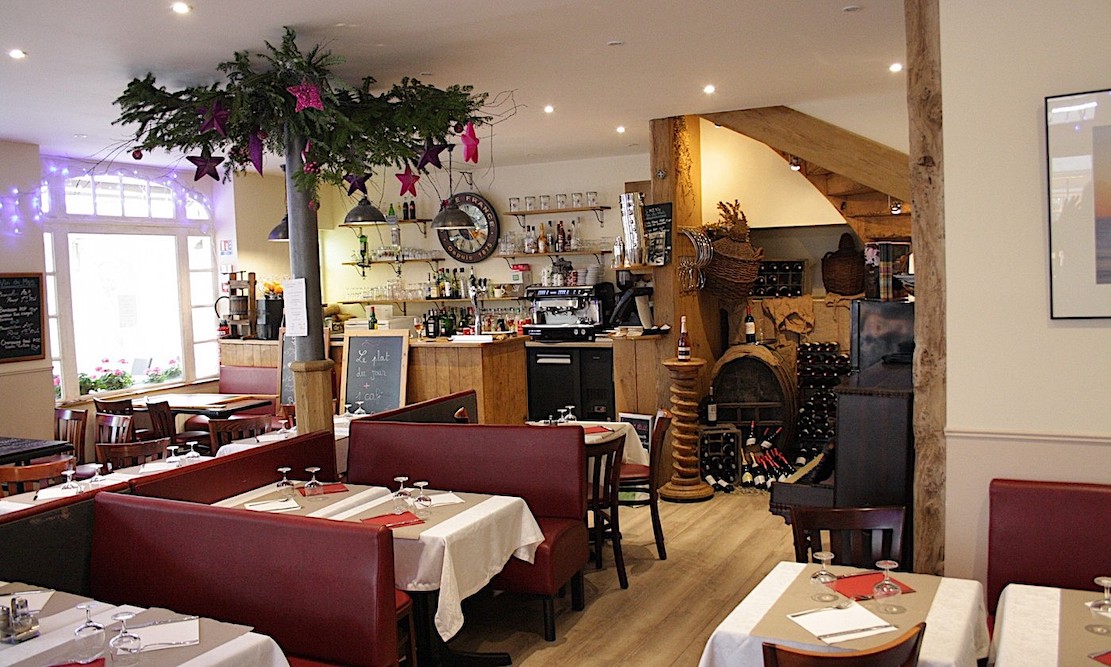 pot
de crème. Le Mermoz
also serves plateaus of icy shellfish and several
non-seafood dishes.
pot
de crème. Le Mermoz
also serves plateaus of icy shellfish and several
non-seafood dishes.
Le
Café de France (2 Rue de
Génèral Charles DeGaulle) is a
homier spot on a corner, identified at night by a
glowing green neon sign and
its outdoor and enclosed terrace tables. They have
a big menu that aims too
hard to please everyone, with hot dogs and
cheeseburgers, but the locals know
to skip the printed 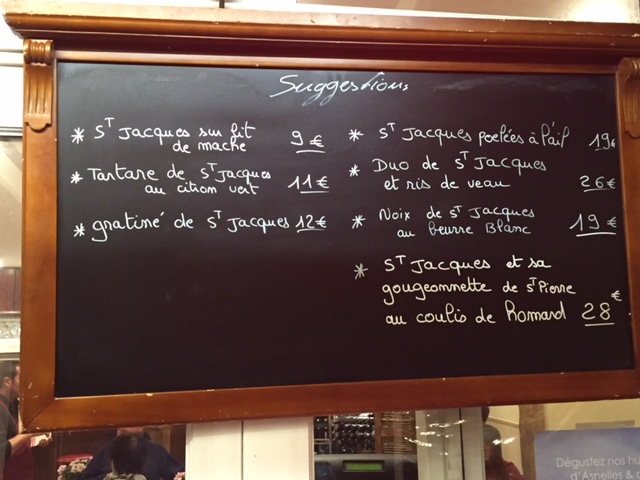 menu
and choose from the
daily blackboard menu (below), with
prices dependent on the market. We did so
—they had an entire blackboard just with scallops
dishes—and were delighted by
an enormous torteau
crab (24€) served
cold with mayonnaise. Mussel soup (14€) was
equally good, and the scallops gratiné (12€)
heady with cream and
cheese, but a bit gummy. Chicken in a cream sauce
(16€) was better, as was tête de veau
with boiled potatoes and sauce
gribiche (19€), and some superb
scallops and fried goujonettes
of
Saint Pierre appeared on one plate (28€). Whenever
I’m in Europe I order turbot
and was not disappointed at Le Café de France with
a fish of meaty flesh and
gelatinous fat. They also do a choucroute
of seafood (26€) and sauerkraut, not unusual
for Normandy, though I didn’t
have a chance to try it. For dessert have the
dependable crème caramel or crème
brûlée (5€ each) or the crêpes (4.50€). There is a
19.80€ three-course menu.
menu
and choose from the
daily blackboard menu (below), with
prices dependent on the market. We did so
—they had an entire blackboard just with scallops
dishes—and were delighted by
an enormous torteau
crab (24€) served
cold with mayonnaise. Mussel soup (14€) was
equally good, and the scallops gratiné (12€)
heady with cream and
cheese, but a bit gummy. Chicken in a cream sauce
(16€) was better, as was tête de veau
with boiled potatoes and sauce
gribiche (19€), and some superb
scallops and fried goujonettes
of
Saint Pierre appeared on one plate (28€). Whenever
I’m in Europe I order turbot
and was not disappointed at Le Café de France with
a fish of meaty flesh and
gelatinous fat. They also do a choucroute
of seafood (26€) and sauerkraut, not unusual
for Normandy, though I didn’t
have a chance to try it. For dessert have the
dependable crème caramel or crème
brûlée (5€ each) or the crêpes (4.50€). There is a
19.80€ three-course menu.
And
don’t forget le trou
normand—the
Norman hole—which is a shot of Calvados around the
middle of the meal that
supposedly helps digestion and builds an appetite
for more food. That, and a
stroll along the strand as the water goes in and
out as it has forever, will
put you in good stead.
❖❖❖
CHAZZ
PALMINTERI
RESTAURANT WHITE PLAINS
264
Main Street
White Plains, NY
914-600-8430
By
John Mariani
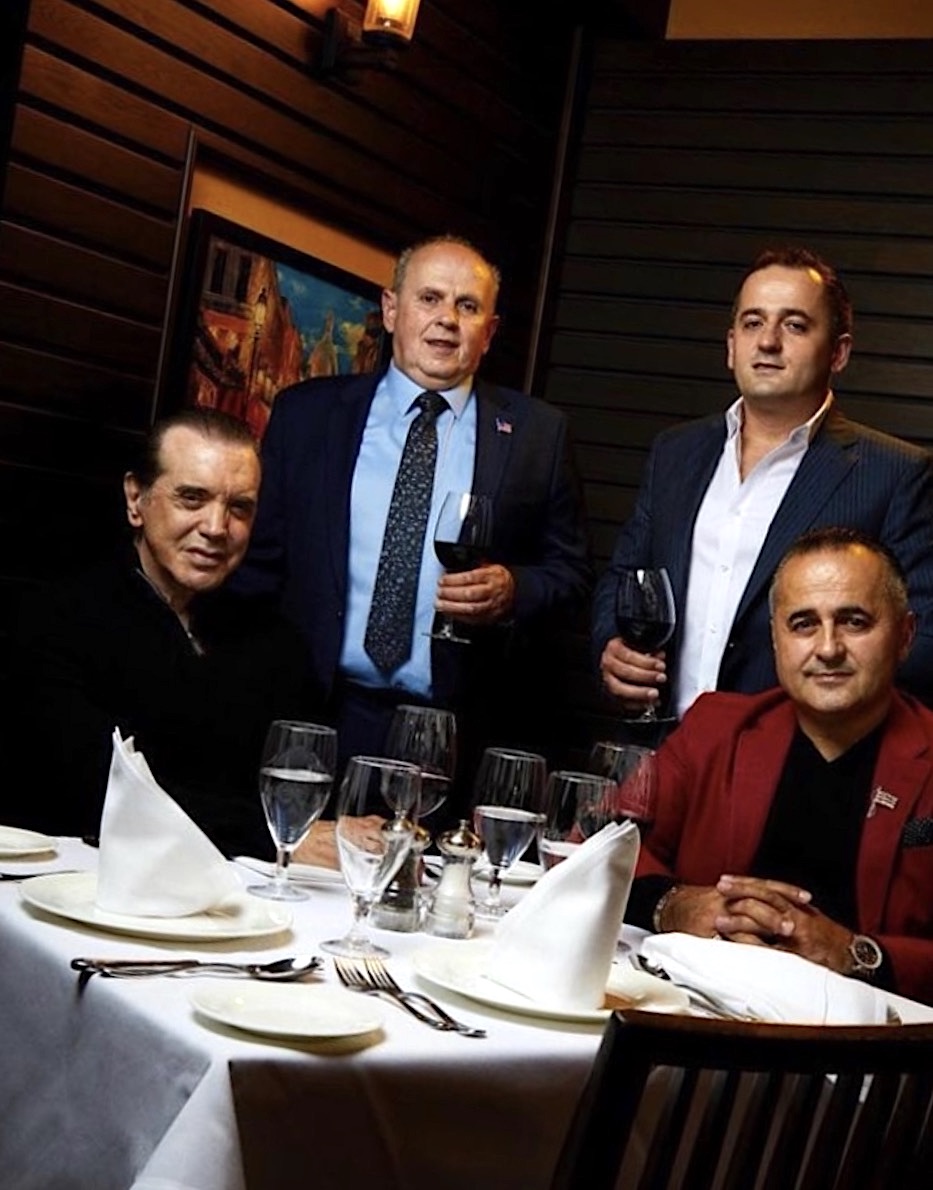
Chazz
Palminteri with partners Russ,
Jeff and Jack Sinanaj
It may not be entirely true that
every Irishmen wants to own a bar, but
a great number of Italian entertainers
have wanted to get into the restaurant
business, as have Frank Sinatra, Dean
Martin, Robert DeNiro, Lou Costello, Francis
Ford Coppola, Madonna, Paul
Sorvino, Liberace, Sonny Bono and Lady Gaga to
name a few. So, when approached
by veteran restaurateurs Jack, Jeff and Ross
Sinanaj (of Empire  Steakhouse
and
Ben & Jack’s), actor/writer Chazz
Palminteri was only too happy to lend his
name and investment to an East Side Manhattan
Italian restaurant, later
re-located to the Theater District. This
summer, again with the Sinanajes, he
debuted Chazz Palminteri Restaurant in the New
York suburb city of White
Plains. Since Chazz lives in nearby Bedford,
he’s usually at the restaurant a
couple of times a week.
Steakhouse
and
Ben & Jack’s), actor/writer Chazz
Palminteri was only too happy to lend his
name and investment to an East Side Manhattan
Italian restaurant, later
re-located to the Theater District. This
summer, again with the Sinanajes, he
debuted Chazz Palminteri Restaurant in the New
York suburb city of White
Plains. Since Chazz lives in nearby Bedford,
he’s usually at the restaurant a
couple of times a week.
Best known for writing, producing,
directing and starring in the one-man
show A
Bronx Tale, about growing up
on Arthur Avenue, which was made into a hit
movie and Broadway
musical with Robert DeNiro,
Palminteri has a long résumé of films that
includes The Usual Suspects, Analyze This,
Legend and—my favorite of his
films—Yonkers
Joe. Palminteri had
previously been part of a restaurant in
Baltimore’s Little Italy, but
overestimated the locals’ taste for Italian food
much above the level of
chicken parm.
Westchester County proportionately may
have as many Italian restaurants
as does Manhattan, but few are this spacious,
and the menu has a sumptuous
variety, with generous portions that make
sharing a real option and taking some
home a high probability. The restaurant also
mimics the Sinanajes’ first-rate
steakhouses in the quality of the meats and fish
served. 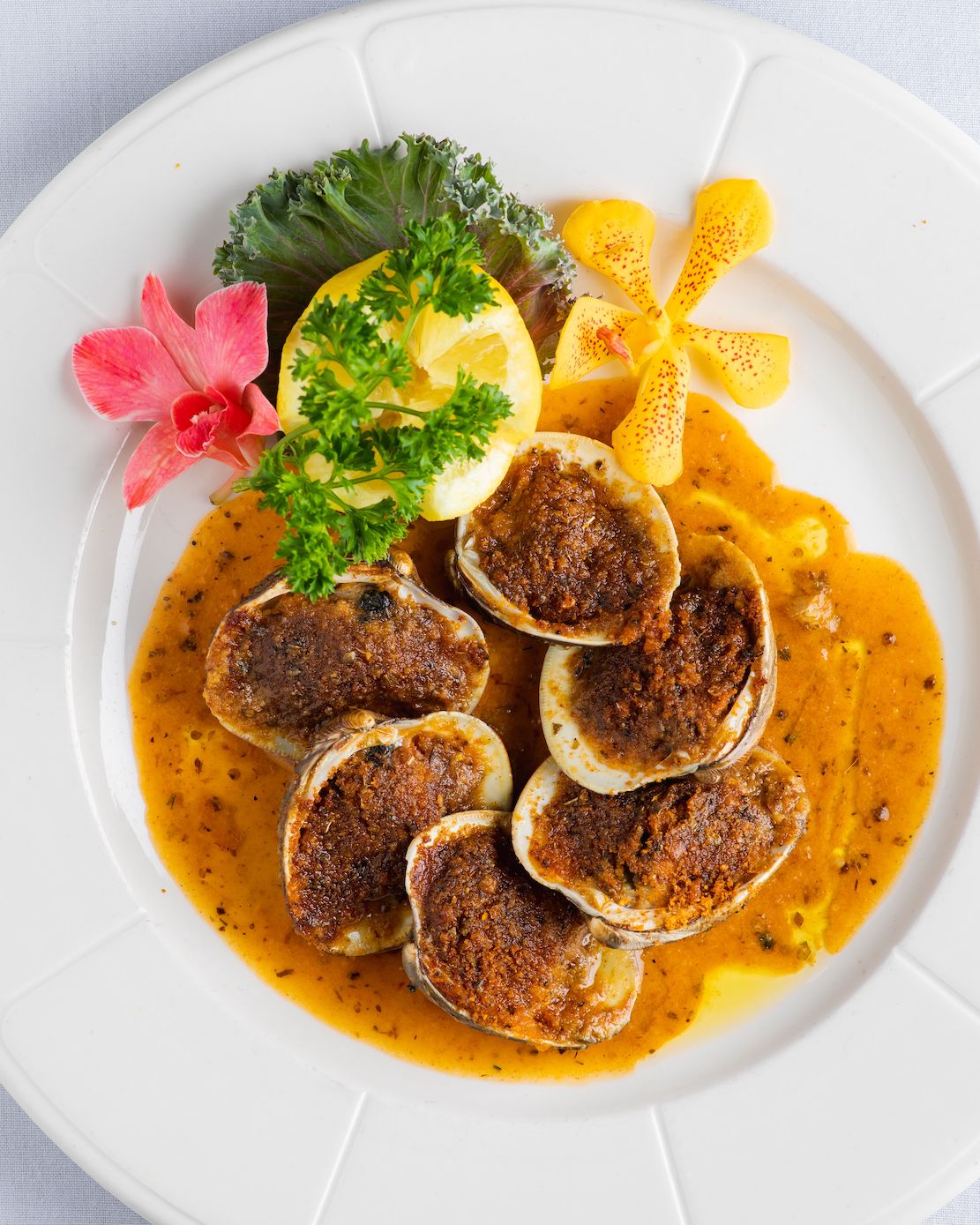
So you may start off with some
Bluepoint oysters ($14.95) or
well-seasoned, not too heavily breaded
clams oreganata ($13.95), as is the eggplant coated
with breadcrumbs topped with tomato sauce and
fresh mozzarella ($13.95).
Meatballs are lavishly topped with ricotta
cheese and tomato sauce ($16.95),
and the shrimp sautéed with chopped spicy
peppers, in a light creamy Gorgonzola
sauce served with garlic bread, could make a
small meal ($15.95). Grilled
octopus gets the welcome addition of
chopped broccoli di rabe, spicy cherry
peppers, capers and olives ($17.95).
You’d expect to
find pizzas, well rendered
with a good crust of the right puffiness and
flavor that can be had with
prosciutto ($19.95) or truffles
($24.95),
as well as short ribs with arugula and sweet
peppers and mozzarella
($19.95). They also have a 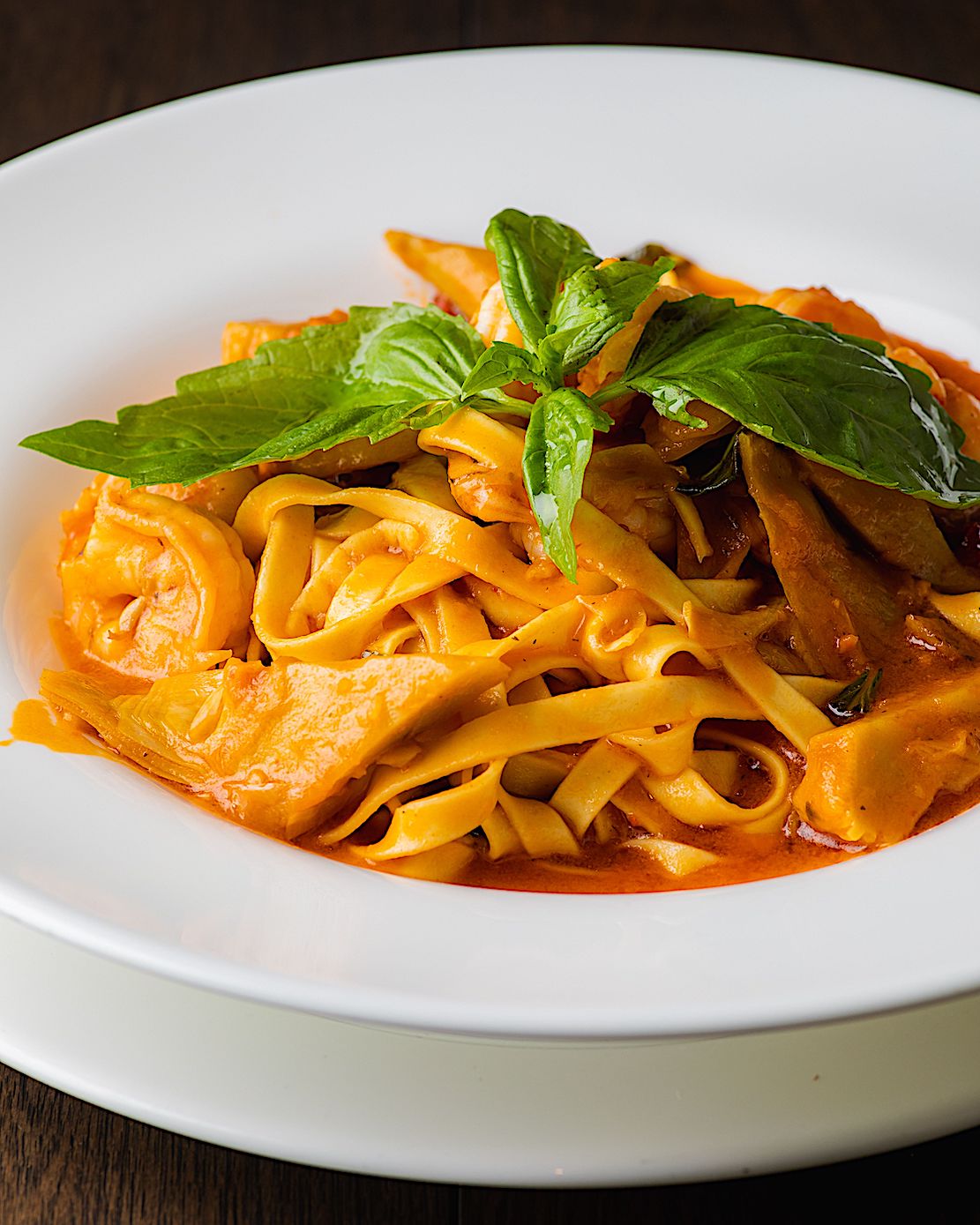 fat
calzone of toasty pizza dough shaped like an old
shoe and stuffed with ricotta and mozzarella,
with fresh tomato sauce
($15.95). (Most
of these items are also
available at the bar.)
fat
calzone of toasty pizza dough shaped like an old
shoe and stuffed with ricotta and mozzarella,
with fresh tomato sauce
($15.95). (Most
of these items are also
available at the bar.)
I don’t think any menu needs 14
pastas, but the ones that I tried were perfectly
made, especially classics like
pappardelle
alla bolognese, ($24.95)
with the right proportion of meat and
vegetables; rigatoni with broccoli di
rabe, sausage, sweet peppers and a pink vodka
sauce ($24.95) and ravioli with
lobster meat inside and lavished with a brandy
cream sauce ($28.95). 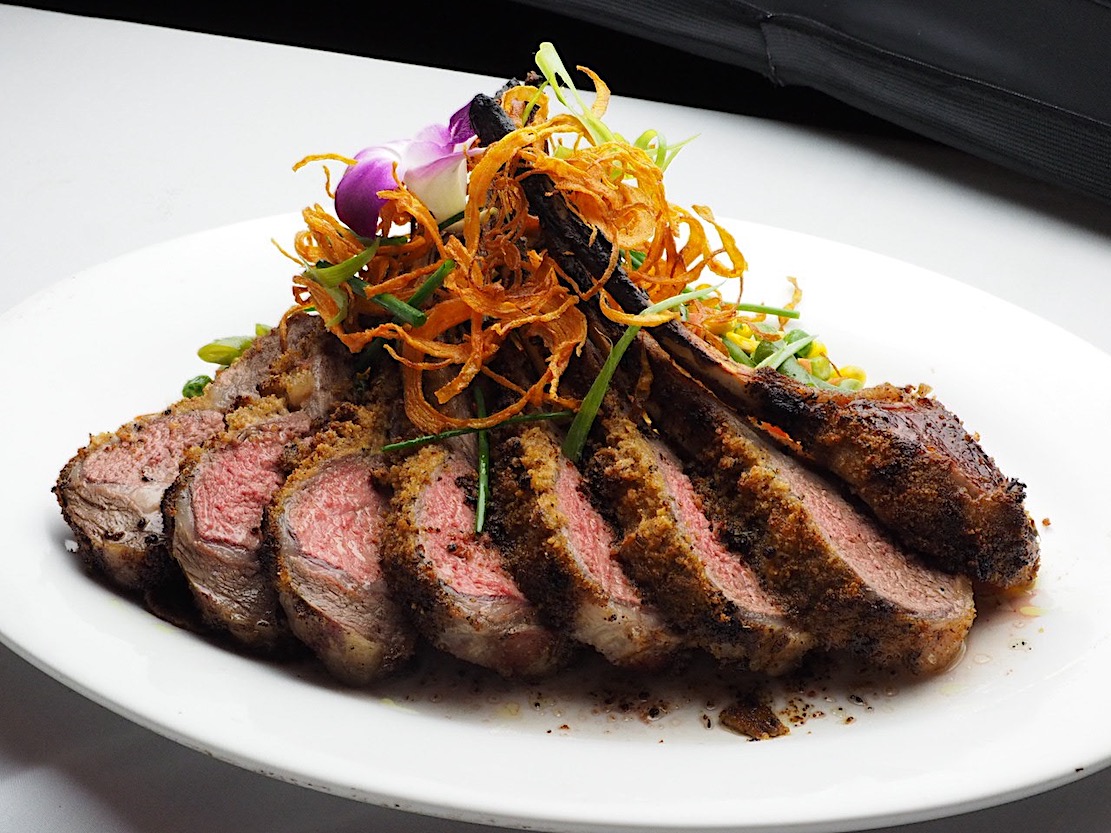 The
bucatini alla carbonara definitely
does not
need “a touch of cream”
($23.95).
The
bucatini alla carbonara definitely
does not
need “a touch of cream”
($23.95).
Had I no appetite for Chazz's Italian
food, I would go for the grilled meats,
especially the large rack of
American lamb with a dark mint sauce with mashed
potatoes and string beans
($48.95) or the USDA Prime sirloin ($49.95).
There’s also a chateaubriand for
two ($99.95).
The Italian items well worth ordering are
the glistening branzino, either baked or
grilled, served with a fresh herb
sauce, garlic
and extra virgin olive
oil, and
the lobster tails “à la Bronx
Tale” with an abundance of clams, mussels and 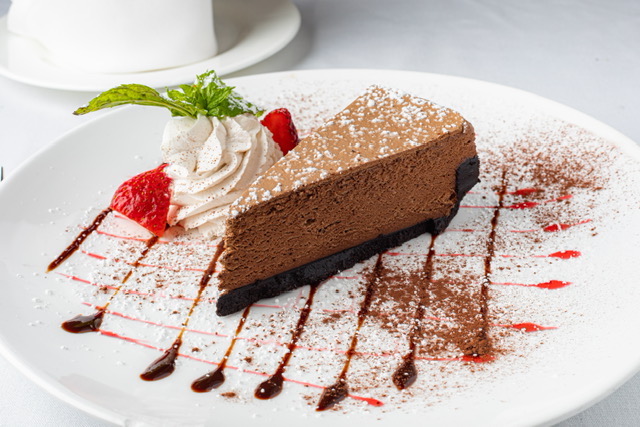 shrimp
sautéed in a light spicy
sauce atop homemade fettuccine ($49.95).
I was not taken with the saltimbocca
alla Romano ($33.95), which was a little
leathery one evening.
shrimp
sautéed in a light spicy
sauce atop homemade fettuccine ($49.95).
I was not taken with the saltimbocca
alla Romano ($33.95), which was a little
leathery one evening.
Desserts like cheesecake and tiramisù are
all housemade and meant to
be shared.
Chazz’s has a thorough wine list, largely
Italian, with 22 wines by the glass
($15.95-$22.95) and a remarkable number of
half-bottles and magnums (where there are some
bargains), and dozens of good
selections under $70.
I can’t guarantee a
sighting of
Palminteri whenever you go—with two restaurants
and a busy career in
entertainment that occasionally has him recreate
the original one-man show of A Bronx
Tale—but I can guarantee one of
the Sinanajes will be there making sure you are
well taken care of and,
unquestionably, well fed.
CAPONE’S
GOLD
 When
Katie an
David returned from lunch, Gaudet was already
seated at the library desk with
several books that looked like ships’ logs.
When
Katie an
David returned from lunch, Gaudet was already
seated at the library desk with
several books that looked like ships’ logs.
“I think I
have some good news for you,” he said, beckoning
them to sit down. “How was
lunch?”
“Fine,” said
David. “So what did you find out?”
“Well, Lloyd’s
Register
of Ships goes back to the 18th century
and is quite complete for the 1930s, so I
was
able to find the log for a rumrunner that
apparently was used by Al Capone,
though the boat was never confiscated.
The log itself apparently was found in
Bimini, dated 1934, and in it,
well, take a look for yourself.”
Gaudet turned
the log around and Katie and David peered at it
without knowing what all the
words and sailing symbols meant.
“This is a
pretty simple log, kept by a captain named
Flynn, who may have worked for
several different clients. He
would keep
his own log, but if this was a secret mission he
might not have carried it
onboard.
“The
name of the
boat was Québec (below)—built in
1918—and he notes that it was hired out by ‘A.
Capone,
Palm Island, Miami.’ He
doesn’t mention
the contents onboard but does note it took a
long time to load and the ‘heavy
displacement,’ meaning the contents made the
boat very low in the water. He
also notes bad squalls in the area.
“Here he
writes ‘meet up with German boat’ and gives the
latitude and longitude for the rendezvous,
which looks to be about 150 nautical miles out
to sea. Now
look at this.”
Gaudet opened
a large printed book entitled German U-Boat
Activity 1934-35 with a Post-It
stuck to one page.
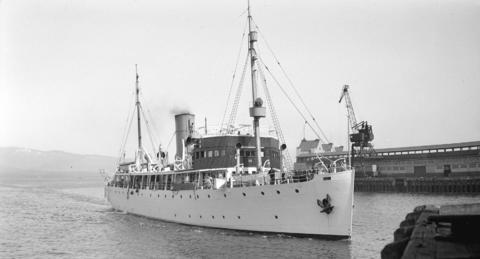
“These are all
the known sailings of U-boats in the western
Atlantic. And on the same date
that the Québec sailed east, a U-Boat
Number 3535—which would have been one of
the newer ones in the Nazi fleet—was heading for
a rendezvous at the exact
co-ordinates as the Québec was.
Katie looked
at David and both said, “My God!”
“But there’s
more to the story,” said Gaudet.
Katie and
David’s eyes were fixed on the archivist.
“The Québec
never made contact with the U-boat.”
“Do you know
why not?” asked Katie, thinking it was an
impossible question to answer.
“I do indeed.
The Québec sank before it got there.”
Katie and
David’s jaws dropped.
“Remember
those squalls Captain Flynn jotted down? Well, I
checked the weather for that
date and those squalls were a tropical storm
that hit Bimini with full
force. Not
quite hurricane strength but
enough to sink a boat loaded down with such
weight.”
“The boat
sank?” exclaimed Katie. “But why wouldn’t the
captain know about an oncoming
storm and refuse to sail?”
Gaudet smiled
and said, “Well, if I were Captain Flynn and I
had Capone’s gangsters paying me
to set sail with a Nazi U-boat waiting for me on
the other end—assuming his
payment for the trip would be very generous—I’d
probably haul up anchor and go
for it. He
probably thought he could get
through the early part of the storm or skirt it
entirely.”
“Wouldn’t he
have radioed Bimini or the U-Boat when the
squall hit him?” asked David.
“He might have
tried to reach Bimini but I doubt he had radio
contact with the U-boat. Maybe
by Morse code.
In any case, the storm must have come up
fast
and hard and swamped the boat, sending it to the
ocean floor.
And that’s the reason the log has no note
on
the Quebec’s return. Captain
Flynn left
it behind and he drowned at sea. Probably
intended to fill it out when he got
back, but he went down with the ship.”
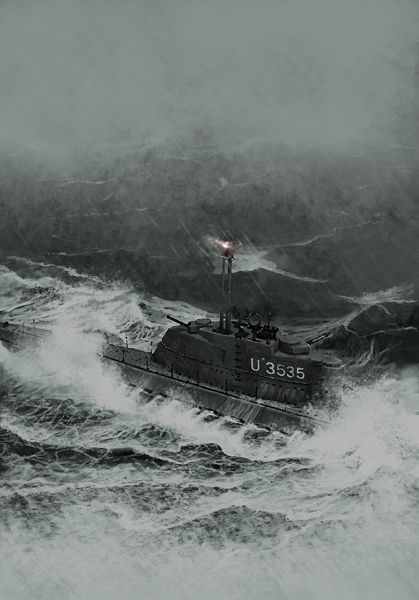 Katie and
David were dazzled by all Gaudet had just told
them.
Katie and
David were dazzled by all Gaudet had just told
them.
“So if all
this is correct,” said David, “then that bullion
is at the bottom of the
Atlantic. How deep is it there?”
“Well, I don’t
know exactly where it sank, but it could be as
deep as 13,000 feet. Believe
me, it has a lot of company down
there with Spanish galleons, which,
incidentally, were also loaded with gold
and silver.”
“Let me try to
absorb all this,” said Katie. “You’re
saying
that the Québec was hired by Al Capone
to run gold bullion
out to a German U-boat in the Atlantic Ocean but
sank in a storm, taking all
the gold with it.”
“Frankly, the
data show it’s far more than reasonable
conjecture,” Gaudet said.
“Well, were
you able to find any other evidence of such
boats making rendezvous with
U-boats at other times?” she asked.
“In a word,
no. And
unless Capone had many more tons
of gold stashed somewhere—not necessarily in the
Caribbean—he could have
brought it down to Bimini by another boat at
another time—I doubt very much he
would take another chance on losing it in
another rendezvous. And
God knows what the Nazi U-boat captain
thought. Not
happy, I suspect.”
“So it’s
therefore unlikely Capone would have risked
losing any more gold after that,”
said David, “because the benefits of it going to
Germany were not enough to
take that risk.
And the Germans must
have assumed Capone was not up to the task.”
David kept
shaking his head. “This is really an astonishing
story. Just
when we think we’ve found where the gold
went, we find out it’s unreachable at the bottom
of the Atlantic Ocean.”
“Well, if it’s
any comfort, from what you told me of the amount
of gold, it would have been
impossible to load all of it in that one
rumrunner.
It was probably a trial run
that failed and the rest of the shipments
ceased. Which
means the rest of the gold has still to
be somewhere else. But probably not in Germany.”
Katie and
David were not about to go through all the leaky
evidence they had for the
whereabouts of the three stashes of gold taken
at the heist, so they thanked
Gaudet profusely and got an evening Amtrak train
back to New York, keeping pretty much
silent on the three-hour trip, falling asleep on
each other’s
shoulders.
© John Mariani, 2015
❖❖❖
ARE BORDEAUX AND BURGUNDY
LOSING THEIR CACHET AMONG THE WORLD'S
TOP WINES?
By John Mariani
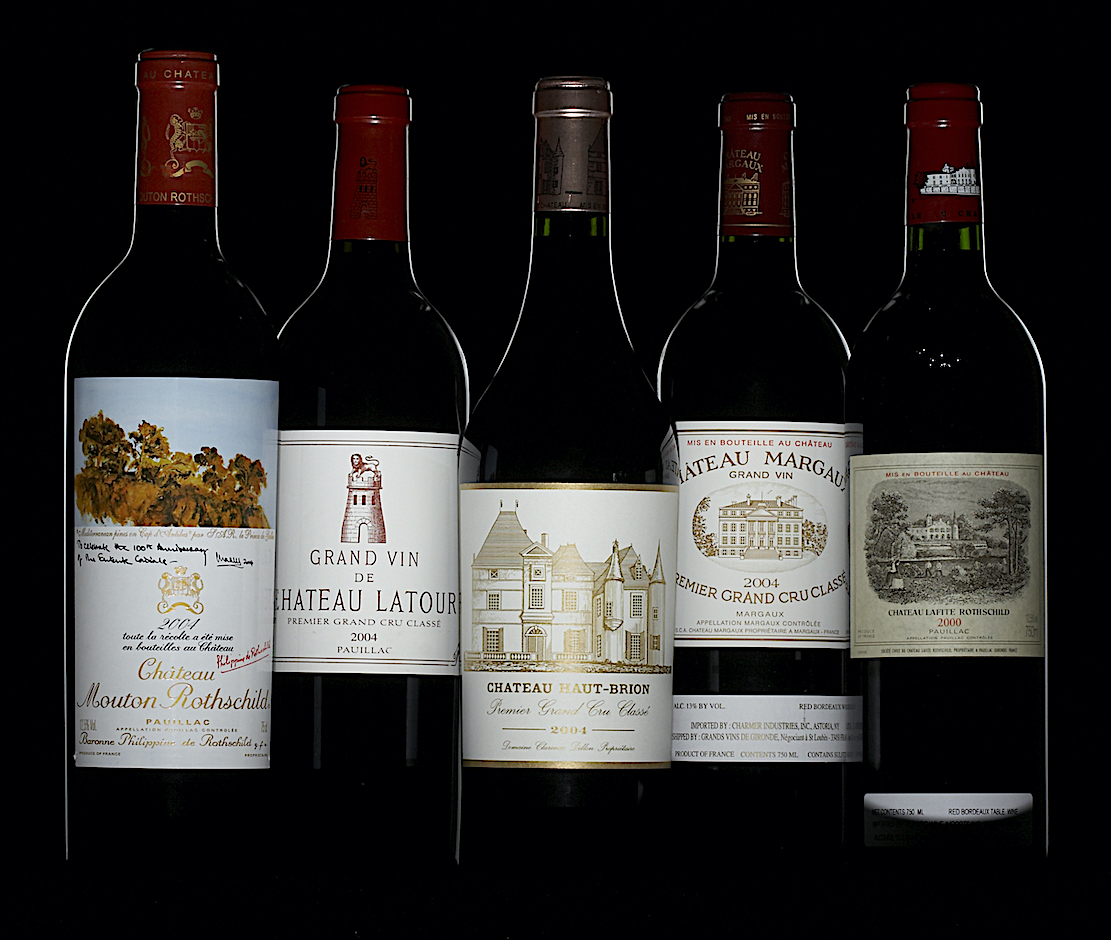
Back in
1855 a group of Bordeaux
merchants at an Exhibition in Paris decided to
make some sense of the myriad
estate vineyards by classifying them according to
which wines consistently sold
for the highest prices within the industry. That
classification, which ranked
wines from premier crus (first growths) to
Cinquième crus (fifth growths, are still the
benchmark today.
Sixty-two among 2,000 vineyards were listed, and,
with only a few shufflings of
rankings and the addition of Chateau
Mouton-Rothschild to the premier crus
later on, the top wines have remained the same,
still bringing top dollar in
the market, along with several great Burdgundies,
like those from the
Romanée-Conti estates.
 But
a just published on-line report by
Liv-ex, a London-based global marketplace for the
wine trade, where 550 fine
wine businesses from around the world buy and sell
wine, indicates that several
California wines now rank among the top. First
published in 2009, the
Liv-ex Classification has been updated every
two years to reflect the
changing conditions of the market, using the 1855
methodology of prices to
determine a hierarchy. California wines including
Harlan Estate, Colgin,
Scarecrow and Screaming Eagle all placed in the
first tier, with some rising
stars like Opus One Overture, Realm
Cellars’
The Bard, Spottswoode’s Cabernet Sauvignon and
Ulysses’ Cabernet Sauvignon.
But
a just published on-line report by
Liv-ex, a London-based global marketplace for the
wine trade, where 550 fine
wine businesses from around the world buy and sell
wine, indicates that several
California wines now rank among the top. First
published in 2009, the
Liv-ex Classification has been updated every
two years to reflect the
changing conditions of the market, using the 1855
methodology of prices to
determine a hierarchy. California wines including
Harlan Estate, Colgin,
Scarecrow and Screaming Eagle all placed in the
first tier, with some rising
stars like Opus One Overture, Realm
Cellars’
The Bard, Spottswoode’s Cabernet Sauvignon and
Ulysses’ Cabernet Sauvignon.
To put the report’s findings in
perspective, I interviewed Liv-ex’s Director and
Head of Sales, Anthony
Maxwell (below). Born in South Africa and
brought up in France before moving to the UK
when a teenager, Maxwell worked for the Foreign
Office in Geneva and the
International Federation of Wines and Spirits in
Paris. He then worked for John
Armit Wines for eight years, running their trading
department and private
client sales department before joining Liv-ex in
2005.
Why do you think this shift away from
French (Bordeaux / Burgundy)
wines is taking place? Does Covid have  anything
to do with it?
anything
to do with it?
There are probably two
reasons for this shift. The first is that the
definition of “fine wine” is now
broader than it once was. It is no longer limited to
just Bordeaux or just
French wines, and as a result this has considerably
opened up the world of fine
wine, especially when other regions can match the
French in terms of quality.
Another reason is due to
buyers searching for greater value and in doing so
they are looking to these
other regions. That being said, French wines
continue to be hugely popular. In
some cases, buyers have shifted to Champagne and the
Rhône in search of value.
Even within Burgundy and Bordeaux themselves, buyers
are looking at
up-and-coming producers and AOCs where prices aren’t
as high. Many of the trends in the
Classification pre-date Covid-19. However, this move
towards a more diverse
market was certainly accelerated.
Are some French wines pricing
themselves out of the market?
I don’t think this is
necessarily the case. As our Power 100 rankings
show, wines from France still
dominate and continue to make up the majority of the
most powerful brands in
the fine wine market. When looking at the components
of
the Liv-ex 1000 index, the Bordeaux 500 index,
which reflects the price
movement of 500 leading wines from the region, is up
5.05% year-to-date and
7.7% over a one-year period. The Burgundy 150,
Champagne 50 and Rhône 100 have
also seen impressive gains over the same periods
too. Prices for French wines are
still rising, but wines from other regions are also
rising and faster too.
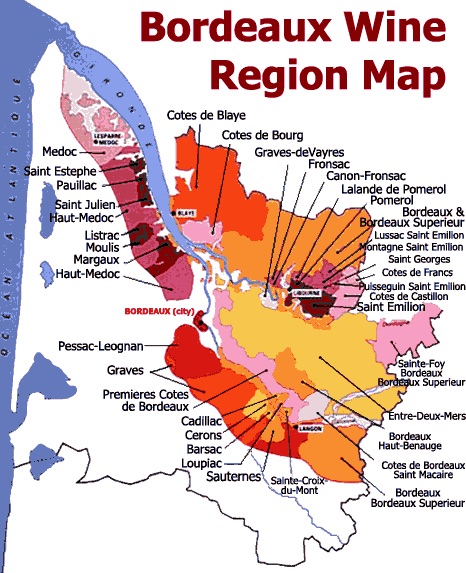 On
a positive note, the Classification
does highlight that value that still exists in
classic French regions. You can
still buy Classed Growth Bordeaux for hundreds of
pounds, not thousands. There
is also some Burgundy that doesn’t cost thousands of
pounds per bottle.
Champagne and the Rhône continue to provide
excellent value among some of their
greatest domains and terroirs too.
On
a positive note, the Classification
does highlight that value that still exists in
classic French regions. You can
still buy Classed Growth Bordeaux for hundreds of
pounds, not thousands. There
is also some Burgundy that doesn’t cost thousands of
pounds per bottle.
Champagne and the Rhône continue to provide
excellent value among some of their
greatest domains and terroirs too.
What are the criteria for inclusion?
In order to qualify for the
ranking, a wine must have traded on Liv-ex between 1
July 2020 and 30 June 2021
in either a 75cl or 150cl bottle format. Standard
in Bond, Standard En
Primeur and Duty Paid trades were all
considered, except for Burgundy,
Champagne, Australia and the USA , where special
trades were also
permitted. Five or more vintages of the wine must
have traded during this
period and the wine must have traded 15 or more
times.
Once a wine qualified for inclusion in the
rankings, the average trade price per 12-bottle case
was calculated and the
wine assigned to a tier with the relevant price
band. The
price bands are updated every two years to
reflect the changing conditions of the market. This
year we adjusted our price
bands in accordance with the performance of the
Liv-ex 1000 index. Between May
2019 (when we last updated our classification) and
June 2021, the Liv-ex 1000
rose by 6.36% and the price bands for each tier were
adjusted to reflect this.
The lowest price bracket was for the 5th tier
(between £306 and £382 per 12×75)
and the highest was the 1st tier (£3,060 and above). 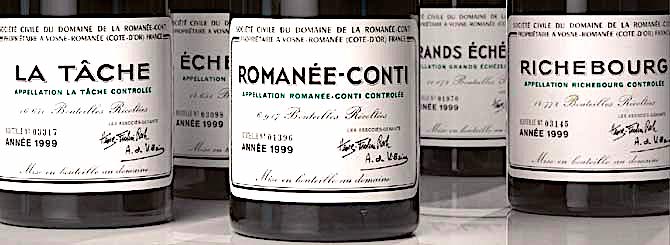
What longer term trend do you see
emerging from this report?
This year’s classification
really cements the secondary market trends we have
highlighted on numerous
occasions over the past year. The first is
Bordeaux’s
declining share of secondary market trade, which is
mirrored in the composition
of the classification over time. In 2019, Bordeaux
accounted for 37% of the
classification, this year it makes up just 28.6%.
The diversification of the
market is another, as more wines from each country
traded. For example, in 2019
U.S. wines only appeared in the top two tiers, but
this year they’re spread
across four. The same can be said for Bordeaux,
Tuscany, Piedmont and the
Rhône, which had wines across all five tiers.
Burgundy was found across four
and Portugal and Australia across three. No doubt as
prices for well-known
regions and brands continue to rise, buyers will
continue to explore
up-and-coming regions in search of greater value.
This trend is likely to
continue.
❖❖❖
 So...What
Exactly Do They Serve?
So...What
Exactly Do They Serve?Veggie Thumper is the name of a restaurant in Des Moines, Iowa.
Any of John Mariani's books below may be ordered from amazon.com.
 The Hound in Heaven
(21st Century Lion Books) is a novella, and
for anyone who loves dogs, Christmas, romance,
inspiration, even the supernatural, I hope you'll find
this to be a treasured favorite. The story
concerns how, after a New England teacher, his wife and
their two daughters adopt a stray puppy found in their
barn in northern Maine, their lives seem full of promise.
But when tragedy strikes, their wonderful dog Lazarus and
the spirit of Christmas are the only things that may bring
his master back from the edge of despair.
The Hound in Heaven
(21st Century Lion Books) is a novella, and
for anyone who loves dogs, Christmas, romance,
inspiration, even the supernatural, I hope you'll find
this to be a treasured favorite. The story
concerns how, after a New England teacher, his wife and
their two daughters adopt a stray puppy found in their
barn in northern Maine, their lives seem full of promise.
But when tragedy strikes, their wonderful dog Lazarus and
the spirit of Christmas are the only things that may bring
his master back from the edge of despair. WATCH THE VIDEO!
“What a huge surprise turn this story took! I was completely stunned! I truly enjoyed this book and its message.” – Actress Ali MacGraw
“He had me at Page One. The amount of heart, human insight, soul searching, and deft literary strength that John Mariani pours into this airtight novella is vertigo-inducing. Perhaps ‘wow’ would be the best comment.” – James Dalessandro, author of Bohemian Heart and 1906.
“John Mariani’s Hound in Heaven starts with a well-painted portrayal of an American family, along with the requisite dog. A surprise event flips the action of the novel and captures us for a voyage leading to a hopeful and heart-warming message. A page turning, one sitting read, it’s the perfect antidote for the winter and promotion of holiday celebration.” – Ann Pearlman, author of The Christmas Cookie Club and A Gift for my Sister.
“John Mariani’s concise, achingly beautiful novella pulls a literary rabbit out of a hat – a mash-up of the cosmic and the intimate, the tragic and the heart-warming – a Christmas tale for all ages, and all faiths. Read it to your children, read it to yourself… but read it. Early and often. Highly recommended.” – Jay Bonansinga, New York Times bestselling author of Pinkerton’s War, The Sinking of The Eastland, and The Walking Dead: The Road To Woodbury.
“Amazing things happen when you open your heart to an animal. The Hound in Heaven delivers a powerful story of healing that is forged in the spiritual relationship between a man and his best friend. The book brings a message of hope that can enrich our images of family, love, and loss.” – Dr. Barbara Royal, author of The Royal Treatment.
 |
The Encyclopedia of American Food and Drink by John F. Mariani (Bloomsbury USA, $35) Modesty forbids me to praise my own new book, but let me proudly say that it is an extensive revision of the 4th edition that appeared more than a decade ago, before locavores, molecular cuisine, modernist cuisine, the Food Network and so much more, now included. Word origins have been completely updated, as have per capita consumption and production stats. Most important, for the first time since publication in the 1980s, the book includes more than 100 biographies of Americans who have changed the way we cook, eat and drink -- from Fannie Farmer and Julia Child to Robert Mondavi and Thomas Keller. "This book is amazing! It has entries for everything from `abalone' to `zwieback,' plus more than 500 recipes for classic American dishes and drinks."--Devra First, The Boston Globe. "Much needed in any kitchen library."--Bon Appetit. |
"Eating Italian will never be the same after reading John Mariani's entertaining and savory gastronomical history of the cuisine of Italy and how it won over appetites worldwide. . . . This book is such a tasteful narrative that it will literally make you hungry for Italian food and arouse your appetite for gastronomical history."--Don Oldenburg, USA Today. "Italian
restaurants--some good, some glitzy--far
outnumber their French rivals. Many of
these establishments are zestfully described
in How Italian Food Conquered the World, an
entertaining and fact-filled chronicle by
food-and-wine correspondent John F.
Mariani."--Aram Bakshian Jr., Wall Street
Journal.
"Equal parts
history, sociology, gastronomy, and just
plain fun, How Italian Food Conquered the
World tells the captivating and delicious
story of the (let's face it) everybody's
favorite cuisine with clarity, verve and
more than one surprise."--Colman Andrews,
editorial director of The Daily
Meal.com. "A fantastic and fascinating
read, covering everything from the influence
of Venice's spice trade to the impact of
Italian immigrants in America and the
evolution of alta cucina. This book will
serve as a terrific resource to anyone
interested in the real story of Italian
food."--Mary Ann Esposito, host of PBS-TV's
Ciao
Italia. "John Mariani has written the
definitive history of how Italians won their
way into our hearts, minds, and
stomachs. It's a story of pleasure over
pomp and taste over technique."--Danny Meyer,
owner of NYC restaurants Union Square
Cafe, The Modern, and Maialino.
|
 |
 |
 |
 |
 |
 |
 Everett Potter's Travel Report:
Everett Potter's Travel Report: 
 Eating Las
Vegas JOHN CURTAS has been covering
the Las Vegas food and restaurant scene
since 1995. He is the co-author of EATING LAS
VEGAS – The 50 Essential Restaurants (as
well as the author of the Eating Las
Vegas web site: www.eatinglasvegas.
He can also be seen every Friday morning as
the “resident foodie” for Wake Up With the
Wagners on KSNV TV (NBC) Channel 3 in
Las Vegas.
Eating Las
Vegas JOHN CURTAS has been covering
the Las Vegas food and restaurant scene
since 1995. He is the co-author of EATING LAS
VEGAS – The 50 Essential Restaurants (as
well as the author of the Eating Las
Vegas web site: www.eatinglasvegas.
He can also be seen every Friday morning as
the “resident foodie” for Wake Up With the
Wagners on KSNV TV (NBC) Channel 3 in
Las Vegas.
MARIANI'S VIRTUAL GOURMET
NEWSLETTER is published weekly. Publisher: John Mariani. Editor: Walter Bagley. Contributing Writers: Christopher
Mariani, Misha Mariani, John A. Curtas, Gerry Dawes, Geoff Kalish.
Contributing
Photographer: Galina Dargery. Technical
Advisor: Gerry
McLoughlin.
If you wish to subscribe to this
newsletter, please click here: http://www.johnmariani.com/subscribe/index.html
© copyright John Mariani 2021


